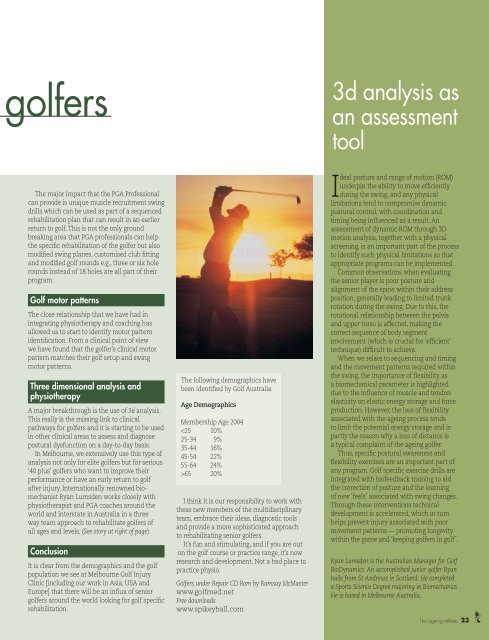Recreational golfers - Ramsay McMaster
Recreational golfers - Ramsay McMaster
Recreational golfers - Ramsay McMaster
Create successful ePaper yourself
Turn your PDF publications into a flip-book with our unique Google optimized e-Paper software.
<strong>golfers</strong><br />
3d analysis as<br />
an assessment<br />
tool<br />
The major impact that the PGA Professional<br />
can provide is unique muscle recruitment swing<br />
drills which can be used as part of a sequenced<br />
rehabilitation plan that can result in an earlier<br />
return to golf. This is not the only ground<br />
breaking area that PGA professionals can help<br />
the specific rehabilitation of the golfer but also<br />
modified swing planes, customised club fitting<br />
and modified golf rounds e.g., three or six hole<br />
rounds instead of 18 holes are all part of their<br />
program.<br />
Golf motor patterns<br />
The close relationship that we have had in<br />
integrating physiotherapy and coaching has<br />
allowed us to start to identify motor pattern<br />
identification. From a clinical point of view<br />
we have found that the golfer’s clinical motor<br />
pattern matches their golf setup and swing<br />
motor patterns.<br />
Three dimensional analysis and<br />
physiotherapy<br />
A major breakthrough is the use of 3d analysis.<br />
This really is the missing link to clinical<br />
pathways for <strong>golfers</strong> and it is starting to be used<br />
in other clinical areas to assess and diagnose<br />
postural dysfunction on a day-to-day basis.<br />
In Melbourne, we extensively use this type of<br />
analysis not only for elite <strong>golfers</strong> but for serious<br />
‘40 plus’ <strong>golfers</strong> who want to improve their<br />
performance or have an early return to golf<br />
after injury. Internationally renowned biomechanist<br />
Ryan Lumsden works closely with<br />
physiotherapist and PGA coaches around the<br />
world and interstate in Australia in a three<br />
way team approach to rehabilitate <strong>golfers</strong> of<br />
all ages and levels. (See story at right of page)<br />
Conclusion<br />
It is clear from the demographics and the golf<br />
population we see at Melbourne Golf Injury<br />
Clinic [including our work in Asia, USA and<br />
Europe] that there will be an influx of senior<br />
<strong>golfers</strong> around the world looking for golf specific<br />
rehabilitation.<br />
The following demographics have<br />
been identified by Golf Australia<br />
Age Demographics<br />
Membership Age 2004<br />
65 20%<br />
I think it is our responsibility to work with<br />
these new members of the multidisciplinary<br />
team, embrace their ideas, diagnostic tools<br />
and provide a more sophisticated approach<br />
to rehabilitating senior <strong>golfers</strong>.<br />
It’s fun and stimulating, and if you are out<br />
on the golf course or practice range, it’s now<br />
research and development. Not a bad place to<br />
practice physio.<br />
Golfers under Repair CD Rom by <strong>Ramsay</strong> <strong>McMaster</strong><br />
www.golfmed.net<br />
Free downloads<br />
www.spikeyball.com<br />
Ideal posture and range of motion (ROM)<br />
underpin the ability to move efficiently<br />
during the swing, and any physical<br />
limitations tend to compromise dynamic<br />
postural control, with coordination and<br />
timing being influenced as a result. An<br />
assessment of dynamic ROM through 3D<br />
motion analysis, together with a physical<br />
screening, is an important part of the process<br />
to identify such physical limitations so that<br />
appropriate programs can be implemented.<br />
Common observations when evaluating<br />
the senior player is poor posture and<br />
alignment of the spine within their address<br />
position, generally leading to limited trunk<br />
rotation during the swing. Due to this, the<br />
rotational relationship between the pelvis<br />
and upper torso is affected, making the<br />
correct sequence of body segment<br />
involvement (which is crucial for ‘efficient’<br />
technique) difficult to achieve.<br />
When we relate to sequencing and timing<br />
and the movement patterns required within<br />
the swing, the importance of flexibility as<br />
a biomechanical parameter is highlighted<br />
due to the influence of muscle and tendon<br />
elasticity on elastic energy storage and force<br />
production. However, the loss of flexibility<br />
associated with the ageing process tends<br />
to limit the potential energy storage and is<br />
partly the reason why a loss of distance is<br />
a typical complaint of the ageing golfer.<br />
Thus, specific postural awareness and<br />
flexibility exercises are an important part of<br />
any program. Golf specific exercise drills are<br />
integrated with biofeedback training to aid<br />
the correction of posture and the learning<br />
of new ‘feels’ associated with swing changes.<br />
Through these interventions technical<br />
development is accelerated, which in turn<br />
helps prevent injury associated with poor<br />
movement patterns — promoting longevity<br />
within the game and ‘keeping <strong>golfers</strong> in golf’.<br />
Ryan Lumsden is the Australian Manager for Golf<br />
BioDynamics. An accomplished junior golfer Ryan<br />
hails from St Andrews in Scotland. He completed<br />
a Sports Science Degree majoring in Biomechanics.<br />
He is based in Melbourne Australia.<br />
The ageing athlete 23<br />
s


